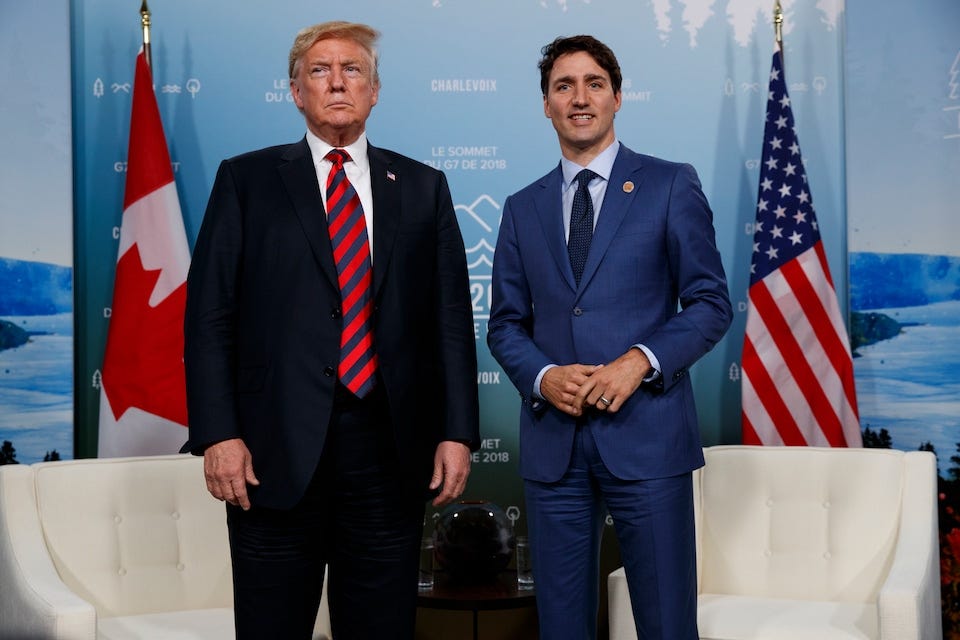The tariff announcement by President-elect Trump is an attempt to set the trade negotiation table before he gets sworn in. It is a smart tactic, and fortunately it is just a tactic — if Canada is smart in our approach to trade negotiations. We were not smart last time.
The “Welcome to Canada” tweet, the “progressive trade agenda” were example of efforts by the Trudeau government to build its political brand as a contrast to that of President Trump. What made things even worse was when Prime Minister Trudeau and Minister Freeland travelled to the United States to reinforce this contrast, thereby violating the “don't you come into my living room and piss on my rug” rule of Canada-US relations. This rule goes back to 1965 when Prime Minister Pearson gave a speech at Temple University in Philadelphia that was critical of US policy with respect to Vietnam and angering President Lyndon Johnson.
Minister Freeland gave a speech in Washington that was widely viewed as a scathing indictment of the Trump administration, while the Prime Minister provided a much more subtle contrast in a university convocation speech at Yankee stadium. These actions were taken amid tense trade and security relations with the United States and the Trump Administration took notice. In this polarized political time, Canada was perceived as not just pissing on the ‘living room’ rug, but venturing right into the bedroom. The speeches were efforts at contrasting Canada and the US by comparing Trudeau to Trump and this was done in the seat of political power and in Trump’s hometown. These actions were not only counterproductive for Canada, but were unserious to the point of foolish.
“Team Canada” built some goodwill with American mayors and governors, which is nice, but they went out of their way to alienate the President and ignore the priorities of the administration. Mexico understood these priorities last time and, despite being in a worse position at the outset of negotiations, fared better and secured a bilateral deal that Canada was invited to join at the end of negotiations.
This time, Canada needs to build common cause with the U.S. and focus on priorities that are in our national interest just as much as they are for the Americans. That is what negotiation is all about. Drive for a negotiated agreement that builds shared interests, while also preparing for your best alternatives in case negotiations go poorly. Based on my involvement in trade issues in the private sector and as parliamentary secretary for international trade in the Harper government, here is what I think Canada needs to do.
First, we should offer to help finance the Keystone XL pipeline and propose a comprehensive energy partnership. This should include collaboration on oil and gas infrastructure, renewable energy technologies and the expansion of nuclear energy in a secure and integrated North American electricity grid. Our nations worked together to build the Alaska Highway during WWII — we can work together now to build an energy highway built on affordability, security and lower emissions.
Second, we should commit to rapidly meet our NATO two per cent of GDP defence spending commitment with a comprehensive plan. This should include becoming a full partner in modernizing NORAD to address emerging threats such as cyberattacks and drone warfare. We must also lead on Arctic security. As climate change opens up new shipping lanes and opportunities for resource exploration, Canada must lead the charge in securing the Arctic in partnership with the U.S.
Third, we should align on trade and emissions policy with the U.S., especially with respect to China’s state-subsidized economies. Auto manufacturing, steel, aluminum, semiconductors and AI and data centres are also key. The government finally began to move in this direction a few months ago. On emissions, Canada could propose a unified North American approach that leverages shared carbon reduction technologies while protecting key industries from unfair competition.
Fourth, we can align on the border and enhance the Safe Third Country Agreement. This should include creating a rapid assessment tribunal to process refugee claims that balances Canada’s Charter obligations with preventing abuse of our system. Further, investments in advanced border technologies, such as AI-driven threat detection systems and pre-clearance programs, can ensure the border remains both secure and open for trade and travel. It is the family and people-to-people connections between Canadians and Americans that are our greatest strength for maintaining strong relations.
Finally, let’s be known as a dependable ally. By consistently demonstrating that Canada meets our international commitments and is committed to contributing meaningfully to the world, we can be a serious voice in advancing international trade and security conversations at this time of global realignment. As a friend, disagreements with the U.S. administration should be shared behind closed doors and not on social media for posturing to political groups in Canada.
It is time to Make Canada Serious Again.







You know, these are the first clear and understandable ideas on dealing with the US that I have heard in a long time. Trudeau, Freeland and the rest of the Liberal freeloaders may think of themselves as progressive but I see them as weak, wimps and woke. Stupid would not be too strong a word. Mr. O'Toole you deserve to be in the next federal government (or provincial) to be a clear-headed vocal leader in this regard.
Excellent suggestions Erin. Border security would be another big one and ensuring our Canadian and US teams work together on border issues, as was intended , when new approaches were brought in during the Chretien years. And lastly show, that we can be a competent member of the five eyes and can be trusted on international security.